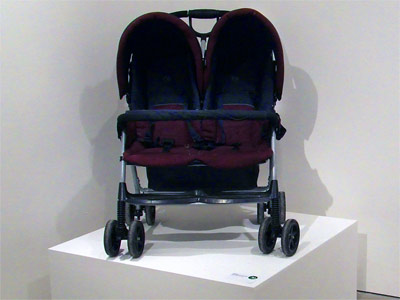joint projects
Lot 1
Contents: 2 infants (not included)
This used, but well conserved double buggy perambulator is a wonderful reminder of the folly of unrestricted growth of the human population before the Last Depression. Since the introduction of the urban one child and rural birth spacing policy this ‘pram’ has become a highly collectable item.
In the year of its production, the then ‘United Kingdom’ (UK) stood at 61 million people. An increase in 2008 of 408,000 births was the steepest rise for 50 years. At a time when the world population stood at 6.78 billion, the increase in so-called ‘developed’ countries, such as the UK, caused specific problems: UK citizens (or ‘subjects’ as they were then) used huge amounts of resources, creating far greater environmental damage per head than the vast majority of the world. For example, in 2009 it was claimed that the average carbon footprint of an individual in the UK was 150 times that of an individual in the Ethiopia, the area now covered by autonomous zones 6-7.
At the time, nearly a sixth of the world’s population were believed to be followers of the Catholic Church, a long-lived, but now thoroughly discredited, pseudo-religious cult.
Its doctrine in essence was to breed more members, proclaiming it immoral to use any form of birth control.

Provenance
“Never, never, never tell a lie.” This should be the first rule of the Catholic Church’s public relations team, according to American Archbishop John Foley, one time head of broadcast media at the Vatican.
Foley was speaking at an Opus Dei conference in 2001 on handling the media and conducting communications for the Catholic Church.1 The 100 plus delegates attending also heard from Joaquin Navarro-Valls, the pope’s spokesman. He warned of the unreliable picture of the world that emerges from the mass media: “I have great fear of people who get all their information from newspapers,” he said.
A decade earlier in 1990, the National Conference of Catholic Bishops was facing a successful pro-choice (abortion) campaign in the United States. In response, it went in search of external public relations help to push their anti-abortion message to an increasingly sceptical public.2 The PR account, estimated to be worth $5million, went to the PR and lobbying giant, Hill & Knowlton, which was once described by a former employee as “a company without a moral rudder” (see also Lot 07). The campaign employed all of the modern PR tricks to win the public over to their anti-abortion position.
When dealing with the press, church PR people should have a “mission statement” in mind, according to Navarro-Valls, the pope’s spokesman. Asked what this mission statement should be, Navarro replied:
- “In one word… salvation”.
1 John L. Jr. Allen; Rome conference studies the media – Catholic Church and public relations, National Catholic Reporter, August 2005
2 Dan Balz, Bishops Enlist PR Firm in Abortion Battle DAN BALZ, Washington Post, April 1990

